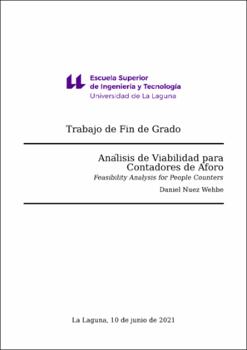Análisis de viabilidad para contadores de aforo.
Autor
Nuez Wehbe, DanielFecha
2021Resumen
Debido a la situación actual a la que nos hemos enfrentado en el año 2020, cada vez es más
necesario mantener un control en los aforos de los establecimientos. Pero consideramos
que este control debe llevarse a cabo de la forma más óptima posible. Por ello se ha
buscado llevar a cabo este estudio de viabilidad para comprobar si es factible crear un
producto que satisfaga estas necesidades, buscando seguir las principales tendencias
actuales del mercado: el Internet de las Cosas y el Big Data.
Partiendo de esta situación inicial, se ha realizado un estudio de diferentes opciones
tanto de hardware, como de tecnologías y herramientas líderes en el mercado, el cual
ha dado lugar a la implementación e interconexión de dos arquitecturas. Por un lado,
encontramos un contador de aforo, basado en Python y OpenCV, ejecutándose en
una Raspberry Pi junto a una cámara USB. Mientras que por el otro, se encuentra
una aplicación web que utiliza las siguientes tecnologías: React, NestJS, TypeScript,
GraphQL; la cual permite acceder a la información que genere el contador de una
manera ágil y sencilla, permitiendo también la administración de los diferentes usuarios
que tengan acceso a la misma.
En Como conclusión, hemos demostrado la total viabilidad de un proyecto de estas
características. La duración estimada del mismo es de unos ocho meses, y el retorno de
inversión se obtendría a los diez meses de comercialización. Además, la solución ofertada
permite una instalación sencilla, un precio competitivo y una gran escalabilidad. Due to the current situation that we faced in 2020, it is increasingly necessary to
maintain control over the capacity of the establishments. Nevertheless, we consider that
this control must be carried out in the most optimal way possible. For this reason, this
feasibility study has been carried out to check whether it is viable to create a product that
meets these needs, seeking to follow the primary market trends: the Internet of Things
and Big Data.
Starting from this initial situation, we have studied different hardware options, leading
technologies and tools in the market, which has led to the implementation and interconnection of two architectures. On the one hand, we find the people counter, based on
Python and OpenCV, running on a Raspberry Pi together with a USB camera. While
on the other, there is a web application that uses the following technologies: React,
NestJS, TypeScript, GraphQL; which allows access to the information generated by the
meter in an agile and simple way, also allowing the administration of the different users
who have access to it.
In conclusion, we have demonstrated the total viability of a project of these characteristics. Its estimated duration is about eight months, and the return on investment would be
obtained after ten months of commercialization. In addition, the offered solution allows a
simple installation, a competitive price and significant scalability.





